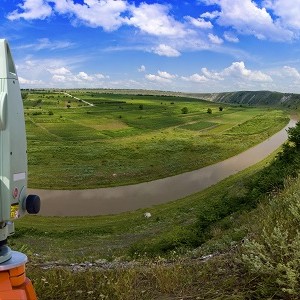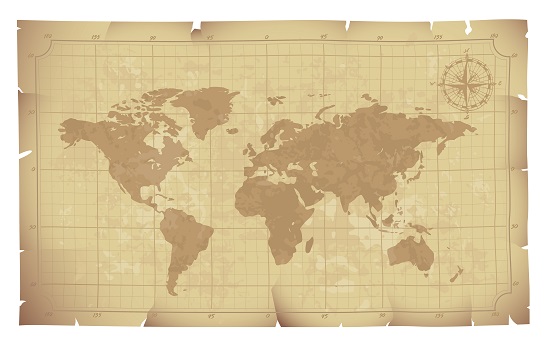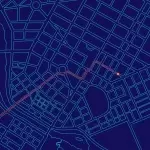
Use of GIS has seen unprecedented growth in the last ten years. With the powerful technology getting cheaper and system memories expanding, meaning that we can handle much bigger sets of data, some say that GIS is in a golden age. It was once the preserve of the cartographer - few outside would have used it or needed it, yet recently GIS has become a core part of modern environmental science degrees. Geology, climatology, geography, statisticians, archaeology, oceanography, conservation based qualification and most other environmental sciences (1) now offer a module at undergraduate level. In the last five years, most universities have offered masters degrees specifically in GIS, or post-graduate certificates and diplomas with a prerequisite of environmental undergraduate degree.
It is surprising to many that this technology has been around for over fifty years (2) because to people outside of the relevant fields, and to some within fields who are just starting to learn about applications and potential for their work, it is still relatively new and exciting with endless possibilities. GIS is something that will make many jobs easier and faster and allow them to do more things in the same space of time with the click of a button. No longer are maps the exclusive preserve of the cartographer, now urban and rural developers, medical resource planners, conservation professionals, environment agency staff (to track and measure floodplains and the spread of protected species) archaeologists and utilities providers are just some of the environmentalist careers that can benefit from digital mapping.
Read more about GIS degrees online.
What is GIS?
GIS - Geographic Information Systems (or Science) - is a piece of software that captures geographic data for the purpose of manipulation, viewing and analysis in whichever context and parameters the user desires or needs. It can be used to analyse spatial data or geographic information for any given and possible purpose.
Why do we need to know this information? Because everything that happens, happens in our street, in our town or city, our county, region, state, province, country and continent. We cannot get away from the location issue and consequently, cannot get away from how the things that happen may or may not affect us (3: p4). The clue is in the word “geographic” because whether we like it or not, whether we understand and appreciate it or not, geography is vitally important in our everyday lives and understanding the geography around us and its importance, is essential to our everyday lives. GIS aims to address and answer the following questions:
- Is this school's catchment areas optimised? Is it overstretched or could we increase the catchment area?
- How do we allocate civil resources to where they are most needed?
- Is this hospital overstretched while this one is barely used? Why is that?
- Where are recorded cases of a certain disease? Are we applying medical resources in the right places to combat it?
- Are our roads in the right place? Should we build more? And where?
- Is our public transport network optimised? What is the contingency if one route is cut off? (the national rail authority in the UK faced a harsh reality in January 2014 when the only rail link to West Devon and beyond was destroyed by storms, something they had prepared for three years previously (7))
- Is aid going to the people who need it most in this disaster zone?
- Is it sensible to build houses here? (is it a floodplain and if so, what would we need to do and how much money would we need to invest in not making it an insurance nightmare)
- Can we legally build houses here? (Is the area an AONB (Area of Outstanding Natural Beauty) or SSSI (Site of Special Scientific Interest) or a conservation area?
- Can we predict where new oil pockets might exist based on data of past oil pockets and existing survey data?
- How has a particular landscape eroded over the last X number of years? Will this erosion be a danger to existing settlements any time soon? (3: 15)
- Which newspapers and magazines sell best in which towns and cities, and even in cities, which districts sell the most copies? Are we providing adequate distribution?
- Where is best to place our new restaurant? A fast food outlet and an exclusive restaurant will both looking for the best site but both may look at different data sets and parameters.
- Which countries, cities and areas are the biggest polluters? What can we do about it? How do we plan our city to minimise pollution of residential areas? (3: 14)
 These questions are vital to our everyday lives but there are other uses, perhaps not useful to the wider population, but certainly to researchers in certain fields. Questions such as:
These questions are vital to our everyday lives but there are other uses, perhaps not useful to the wider population, but certainly to researchers in certain fields. Questions such as:
- What is the geographic distribution of certain endangered plants or animal life? What can we learn from this new distribution?
- How did this surname spread and in which part of the country is it most prevalent (3: p7-10)?
- Can we find as-yet undiscovered buried features by plotting local finds? (for example Roman pottery in high density of one area may lead to a villa that we've not yet found)
- How can we plot the spread of migrating peoples during a particular era using specified data types? (for example, looking at and plotting known dates of burial can demonstrate
The potential of GIS is limitless (1) in many of the cases above, particularly for those concerned with resource planning, complex formulas are calculated to ensure the most efficient delivery. Whether you know it or not, your daily life relies heavily on GIS.
How Does GIS Work?
The questions in the previous section rely heavily on geographic data and it is estimated that the vast majority of data handled by computers these days has and requires specific geographic parameters (5). Taking the example of the two restaurants as a starting point, they may look at different data sets:
- The fast food joint may look at maximising their catchment area and accessibility: they will look at busiest roads, the best junction to place at, close to leisure areas such as shopping malls or other non-exclusive entertainment issues - efficiency and maximisation of profit.
- The exclusive restaurant will look primarily at desirability and facilities that best reflect their image. Even though they too will be concerned with maximising their profit, they are less concerned with numbers and more concerned with image. They may appear near other exclusive restaurants, near theatres and other high-class leisure facilities.
Both may use GIS to find the ideal location and can access any number of websites to collect relevant data for their business plan. This information makes it easier to manage what we know and to extrapolate that which is most useful to us based on the widest variety of relevant data (3: p11). In this respect, GIS is problem solving using geographic means and its co-operative method of sharing pure and unbiased raw data (3: 22) has made it the ideal candidate for everything that affects our environment or how our environment might affect us.
It helps better decision making and as most people prefer visual medium, there is no better visual communication medium than a map (4) so long as you are making it clear what the person is looking at. Maps are immediately identifiable and engaging, and a flexible and universal method of communication within a discipline, between disciplines and to the public as a whole. How it is compiled comes in four elements (1) which are data acquisition, storage & retrieval, transformation & analysis (which may include statistics and the production of models) and reporting (which will include the maps, tables and any associated reports) of data that may previously have been unrelated but will serve a useful function to someone, somewhere (5). Not everyone will be involved in all of these processes but most GIS technicians are charged with locating data that is collected by others and need to know how to acquire and manipulate the data as well as produce maps that are useful. It is a co-operative system limited (1) only by the technology of the day.
History of GIS
There is some debate over when true GIS really started, thanks to the disparate technologies that came together to give us GIS as we understand it today (1), but effectively it has been around since the early 1960s. Advocates claim that it was truly born in 1962 with the first CLI conference (Canadian Land Inventory) that set out to produce masses of data of maps of Canada covering a large number of potential uses and data sets (2). The conference produced these maps using the old methods but it was first theorised here that in future, such data could be produced using the developing computing technology as data got bigger and potential to explore it became more and more complex (8).
The next few decades saw the technology strictly limited to those who had the resources: the hardware and the software were both expenses that had to be justified for the business or the industry, hence that fossil fuel companies represent some of the earliest groups to take up the technology. The 1980s when home computing was increasingly the norm and IT technology began to spread its wings, the business ESRI was formed. Today they are famous for the popular package ARCGIS; the second most popular package in the world today is MapInfo and the corporation was also formed in the same decade (10). But it would be some time before their software - as popular and as useful as it was - would be anything more than a niche interest.
 GIS would not begin to grow until the birth of the internet; even when uptake was relatively slow, those for whom the internet was proving a useful business tool finally saw the potential for the affordability of GIS (3: 22). Historians of technology believe that the increasing portable nature of the internet of the last ten years has really aided GIS technology to experience its growth in the same period (3: 23). Why? Because data collection and transmission became so much easier as well as less costly than it had been before. Suddenly, GIS was no longer just available to the big companies who could afford to invest in the technology to gather and manipulate it, but to everyone. Charities could collect data relatively cheaply, as could conservation organisations and land authorities, town councils and urban planners. None of these groups need rely on older and slower methods of data collection when they could do so far more cheaply. Now, non-profits and even the general public had access to the same data previously only afforded to private industry and governments (5). A great example of this is the UK Environment Agency website that has collated data from a number of government agencies and NGOs and made it freely available for public use (6).
GIS would not begin to grow until the birth of the internet; even when uptake was relatively slow, those for whom the internet was proving a useful business tool finally saw the potential for the affordability of GIS (3: 22). Historians of technology believe that the increasing portable nature of the internet of the last ten years has really aided GIS technology to experience its growth in the same period (3: 23). Why? Because data collection and transmission became so much easier as well as less costly than it had been before. Suddenly, GIS was no longer just available to the big companies who could afford to invest in the technology to gather and manipulate it, but to everyone. Charities could collect data relatively cheaply, as could conservation organisations and land authorities, town councils and urban planners. None of these groups need rely on older and slower methods of data collection when they could do so far more cheaply. Now, non-profits and even the general public had access to the same data previously only afforded to private industry and governments (5). A great example of this is the UK Environment Agency website that has collated data from a number of government agencies and NGOs and made it freely available for public use (6).
Today, most organisations that collect and use data make information available to almost anyone. Though confidential data may require that the user register on a site and sign a non-disclosure agreement, the nature of Big Data coupled with the exponential growth of Web 2.0 and how that data is used means that anyone can produce useful maps (3: 24-25). In the early days, GIS was concerned with how the world looks but less concerned with how it works. This is a result of the growth of technology, decreasing price of the technology and the fact that we can do more things with more data (3: 44-45).
Real World Example Applications of GIS
Disaster Management
Hurricane Katrina is seen by many as the first time that GIS was used a disaster management tool. Thanks to newly available technology, the first responders on the ground shared a great deal of data about street plans - particularly which streets were and were not accessible and the extent of the flooding. Despite that FEMA and the government came in for criticism, many agree that the efforts of data transmission both prior to and during initial relief efforts were vital to relief efforts (3: 5-6).
2014 was a terrible year for drought for the SW United States. Increasingly, GIS is being used to manage environmental problems and specifically in disaster relief. Environmental experts have plotted the reporting of official droughts in most of these areas and shape files are now available (9) of the affected region.
Crime Statistics
GIS is now vital to law enforcement and planning in terms of crime statistics. Though most police forces in the USA have used them for a long time, automated and digital mapping of reported crime has made the process much easier, especially when looking at different types of crime from different departments in larger cities. The ability to share maps and look for correlations between different types of crime can give police a much better idea of an overall picture of a wider region (11). The study cited here also permitted community leaders and the police to get a better understanding of each other, facilitating two-way dialogue.
Archaeology
GIS is now critical to many elements of archaeology as it takes on more elements and characteristics of an environmental science. There are many applications in the field of historical research but none has been more beneficial than the prediction of historic site location (12). Several US universities recently plotted an area to the south of the Caucasus to identify prehistoric sites and areas that may have potential for future on-the-ground research, most notably of the migration route out of Africa in antiquity. The project successfully identified a number of potential new sites for future investigation.
Civic Planning
GIS has been a superb tool for rural and urban planning for the last few decades, working out local tax rates, planning desirability and mapping social deprivation, where new roads could go or which should be prioritised for repair. It is now a vital part of our green future too (13). As with regular and previous methods of planning utilities, using the landscape is far more critical to planning. Cascade in Montana is a prime site for wind farms and there is a website that uses GIS data to plot wind speeds over the course of a year in order to best site the wind farms.
Health / Medical Resource Management
GIS is vital to the proper planning and analysis of the provision of cancer services for the UK socialised healthcare system, the NHS (National Health Service) (14). The package is used to plan and examine a number of issues including catchment areas for GP surgeries. A study recently found that there was greater provision for cancer treatment in the midlands than the actual population. Such maps are used to better manage resources of the NHS.
Transport
One of the biggest public works in the UK right now is the planned High Speed 2 (HS2) rail connection between London and Manchester and then later beyond that. It plans to upgrade and revolutionise the rail network in the UK, arguably starved of much-needed modernisation since privatisation in the 1980s. Because of the massive amount of planning involved, including that many agencies have input into the project, it would have been a logistical problem with the massive amounts of data available and collected on a dedicated GIS site in order that the best decisions are made while respecting local infrastructures and the environment (15).
This above list is only a small selection of examples of GIS' functionality. Any industry or area of resource management where there may be a geographical element may benefit from the advantages of using GIS. It is increasingly vital in many jobs today.
Additional GIS Content Regarding Environmental Science:
- Agricultural Science & GIS
- Climate Science & GIS
- Environmental Biology & GIS
- Environmental Engineering & GIS
- Environmental Microbiology & GIS
- Environmental Planning & GIS
- How Sustainability Uses GIS
References
- http://www.esri.com/news/arcnews/fall12articles/the-fiftieth-anniversary-of-gis.html
- Longley, P.A., Goodchild, M.F., Maguire, D.J. & Rhind D.W. 2011: Geographic Information Systems & Science (Third Edition). Wiley: Hoboken, New Jersey
- http://www.esri.com/what-is-gis
- http://www.mapcruzin.com/what-is-gis.htm
- http://www.geostore.com/environment-agency/
- http://webarchive.nationalarchives.gov.uk/20130402151656/http://archive.defra.gov.uk/environment/climate/documents/adapt-reports/06road-rail/network-rail.pdf
- http://gisandscience.files.wordpress.com/2012/08/4-computermapping.pdf
- http://mapcruzin.blogspot.co.uk/2014/09/drought-maps-and-charts-updated-weekly.html
- http://wiki.osgeo.org/wiki/Open_Source_GIS_History
- http://www.esri.com/news/arcnews/winter1112articles/predicting-prehistoric-site-location-in-the-southern-caucasus.html
- http://www.esri.com/library/brochures/pdfs/gis-for-green-government.pdf
- https://www.wmciu.org.uk/
- http://webarchive.nationalarchives.gov.uk/20141027142236/http://www.hs2.org.uk/news-resources/hs2-gis-information
- Guide to Parasitology - November 19, 2018
- Deserts as Ecosystems and Why They Need Protecting - November 19, 2018
- Conservation: History and Future - September 14, 2018
Related Articles
Featured Article

Cartography: More Than a View From Above





